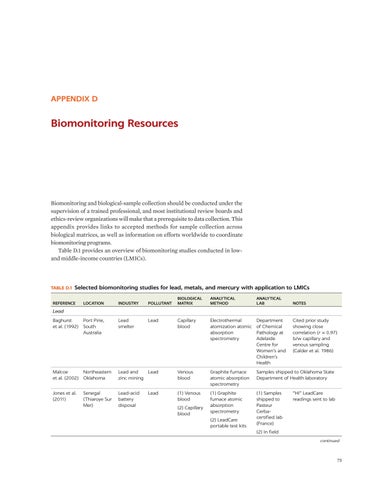APPENDIX D
Biomonitoring Resources
Biomonitoring and biological-sample collection should be conducted under the supervision of a trained professional, and most institutional review boards and ethics-review organizations will make that a prerequisite to data collection. This appendix provides links to accepted methods for sample collection across biological matrices, as well as information on efforts worldwide to coordinate biomonitoring programs. Table D.1 provides an overview of biomonitoring studies conducted in lowand middle-income countries (LMICs).
TABLE D.1
Selected biomonitoring studies for lead, metals, and mercury with application to LMICs
REFERENCE
LOCATION
INDUSTRY
POLLUTANT
Port Pirie, South Australia
Lead smelter
Lead
BIOLOGICAL MATRIX
ANALYTICAL METHOD
ANALYTICAL LAB
Capillary blood
Electrothermal atomization atomic absorption spectrometry
Department of Chemical Pathology at Adelaide Centre for Women’s and Children’s Health
NOTES
Lead Baghurst et al. (1992)
Cited prior study showing close correlation (r = 0.97) b/w capillary and venous sampling (Calder et al. 1986)
Malcoe Northeastern et al. (2002) Oklahoma
Lead and Lead zinc mining
Venous blood
Graphite furnace atomic absorption spectrometry
Samples shipped to Oklahoma State Department of Health laboratory
Jones et al. (2011)
Lead-acid battery disposal
(1) Venous blood
(1) Graphite furnace atomic absorption spectrometry
(1) Samples shipped to Pasteur Cerbacertified lab (France)
Senegal (Thiaroye Sur Mer)
Lead
(2) Capillary blood
(2) LeadCare portable test kits
“HI” LeadCare readings sent to lab
(2) In field continued
75

